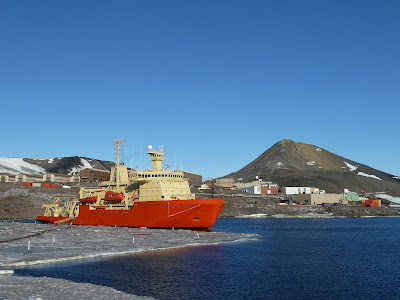8:30pm Sunday, 2/12/2012
12°F
The weather has taken a turn today. It is really cold outside! This afternoon it was only a little warmer, a balmy 13°F. This evening I am going to share some photos from the lab I have worked in during the last two months. This is my last night in Antarctica. I have had an amazing time here and I will remember this trip for all of my life. I had several great trips out in the field, but I also spent a lot of time in the lab in the Crary building in McMurdo operating the TOC ("total organic carbon") instrument made by Shimadzu, which my research group uses to measure nonpurgeable organic carbon (NPOS) and total nitrogen (TN). We measure NPOC and TN of the lakes in Taylor Valley and Miers Lake, while we only measure NPOC in the streams because we have to use a different catalyst in the instrument because the streams can have very low concentrations of organic carbon. I analyzed between about 275 and 325 samples this summer.
 |
The door to the lab I worked,
room 107 on the top level |
 |
The hallway where my lab is
located |
Our lab in the Crary building isn't too interesting on the inside (or the outside, for that matter), but I spent a LOT of time there so I thought I should share some photos of it and the instrument I've operated all season.
 |
The instrument! Meet the Shimadzu TOC Analyzer. The cylindrical
piece on the far left is the auto-sampler, the middle box is the main
instrument that measures organic carbon, and rectangular box on
the right measures total nitrogen |
 |
The standards I analyze with every suite of samples to calibrate
the raw data |
It is really nice that this instrument has an auto sampler. The instrument can be set up to analyze 40-70 samples, which includes standards, blanks, and duplicates. Each "run" can take 20 to 48 hours because ever sample takes 20-30 minutes to complete. The actual analysis takes 8-12 minutes because the instrument analyzes each individual sample 3 to 5 times, depending on how well the instrument deems each analysis of an individual sample.
Water samples for analysis with this instrument are collected in the field in amber glass bottles that have been cleaned and heated in a furnace to destroy any organic material on the bottles. The plastic caps of the sample bottles are cleaned in acid. After collected, the sample water is filtered and a small amount of hydrochloric acid is added to the sample to lower the pH to 2-3.
 |
Auto-sampler with ~70 samples loaded up and in use. The samples are
transferred to 24 mililiter glass vials for analysis |
 |
The needle of the auto-sampler sucking up a sample from a
glass vial |
I kind of understand the inner-workings of the instrument. The sample is extracted from a glass vial in the auto-sampler and then it is "pumped" to an 8-port valve, which leads the sample to a glass syringe. In the syringe, the sample is "sparged" for 90 seconds, which simply means that air passes through the sample for 90 seconds. This drives out dissolved inorganic carbon in the sample.
 |
8-port valve (octopus-like apparatus) with the glass
syringe below it |
 |
Sparging a sample!! This is in the glass syringe.
It was very exciting the first time Kathy and I
got the instrument working and saw it do this. |
The sample is next passes through a catalyst in a furnace at about 700°C (1300°F) and the organic carbon is converted to inorganic carbon in the form of carbon dioxide (CO2) gas. The sample is finally analyzed by ion chromatography.
 |
The furnace! There's a glass tube with catalyst material in it within
the furnace. It is literally red hot! |
The instrument is connected to a computer. We have a program for operating the instrument and the auto-sampler. It isn't a very user-friendly program, but it isn't too difficult to use once you get the hang of it.
 |
| A sample run set up and a window open to view the raw data |
 |
Raw data. This sample, which is Lyons Creek that is named after
my PhD adviser W. Berry Lyons, had 5 sample injections. The
sample injections are represented by the bumps in the blue line.
The program decided to exclude the first two injections because
they were statistically "off." |
Well, that is all I have the energy for tonight. I might try to post again tomorrow about the exhibits in the lab building I worked in and a couple more landscape photos.
I am looking forward to my two full days in Christchurch, New Zealand before I head back to the States. I plan to visit Akaroa for one of my days in Christchurch. My plan is to rent a kayak for a few hours to explore Akaroa Harbor and maybe see some dolphins along with the beautiful harbor. Hopefully I will get some great photos in New Zealand and I'll post some of those when I get back to California as my final post.
 |
| The bus route for my day trip to Akaroa |
































